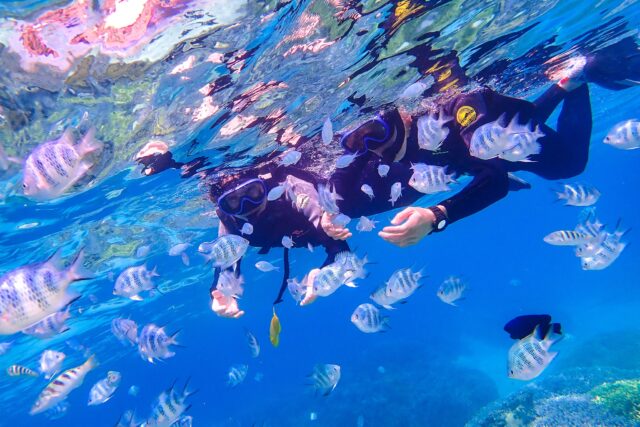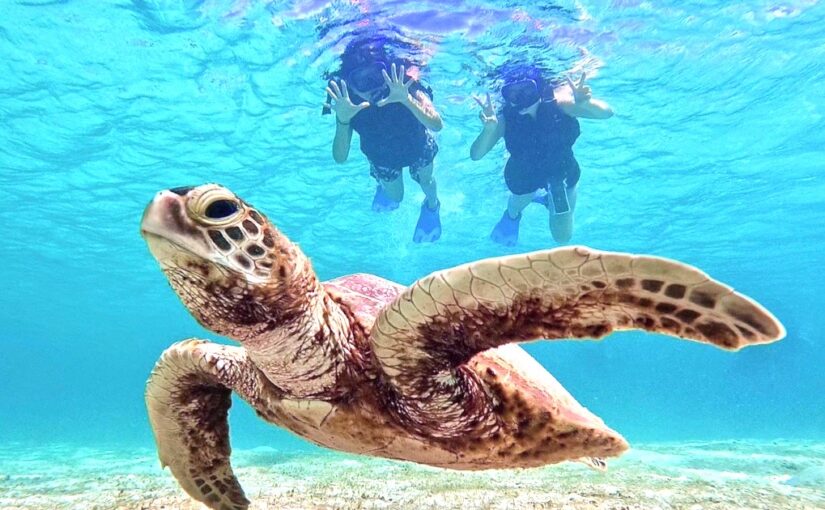18 fish commonly seen in the sea of Miyako Island! Let's look for them with your children as a family!
Table of Contents
- 1 How many can you discover? 18 fish that inhabit Miyako Island!
- 2 Meet the fishes of Miyako Island♪ Recommended Activities
- 3 18 recommended tropical fish in Miyako Island!
- 3.1 yellowtail sergeant (Abudefduf notatus)
- 3.2 yellowfin goatfish (Mulloidichthys vanciolensis)
- 3.3 latticed butterflyfish (Chaetodon rafflesii, species found in the Indo-Pacific)
- 3.4 Papuan black snapper (Lutjanus goldiei)
- 3.5 sea turtle
- 3.6 clownfish (Balistoides conspicillum)
- 3.7 yellow tang (Zebrasoma flavescens, species of Pacific tang)
- 3.8 black sea cucumber (Holothuria atra)
- 3.9 titan triggerfish (Balistoides viridescens)
- 3.10 convict surgeonfish (Acanthurus triostegus, species of the Indo-Pacific)
- 3.11 saddleback butterflyfish (Chaetodon ephippium, species of the Indo-Pacific)
- 3.12 sixbar wrasse (Thalassoma hardwicke)
- 3.13 moorish idol (Zanclus cornutus, species of Indo-Pacific perciform fish)
- 3.14 blue-green chromis
- 3.15 yellowtail amberjack (species of fish, Seriola lalandi)
- 3.16 bluestreak cleaner wrasse (Labroides dimidiatus)
- 3.17 pinktail durgon (durgeon) (triggerfish) (Melicthys vidua)
- 3.18 whitetail dascyllus (Dascyllus aruanus, species of damselfish from the Indo- West Pacific)
- 4 summary
How many can you discover?
18 fish found on Miyako Island!

Miyako Island in Okinawa is known for its crystal clear waters with rich coral reefs.
Such is the sea of Miyakojima,Colorful and unique fish inhabitThe fish are very common, and can be seen while snorkeling or diving.
◆Love colorful tropical fish and creatures
◆If you are looking for activity tours in Miyako Island
◆Considering snorkeling in Miyako Island
Introducing 18 species of fish commonly seen in the sea of Miyako Island, and explaining their characteristics and points of observation.
Meet the fishes of Miyako Island♪
Recommended Activities

The colorful fish of Miyako Island will fascinate you with their beauty just by looking at them from the sea.
But if you've come all this way to visit, you're going to need more.Activities that bring you closer to fishI would also like to try my hand at
Here are some recommended marine activities on Miyako Island!
Click here to see the ranking of popular tours in Miyako Island.
snorkeling

Snorkeling is the best way to easily enjoy the sea of Miyakojima! Swim around the coral reefs and colorful tropical fish will come right up to you.
Because you can see abundant underwater life even in shallow water,Families with young childrenBut you can easily experience it.
Click here for ⬇︎ recommended snorkeling tours.
 Special Winter SALE [Miyako Island/2 hours] Same-day reservations OK! Amazing encounter rate♪ Sea turtle snorkeling tour Beginners welcome☆ (No.934)開始時間8:30-10:00 / 10:30-12:0013:30-15:00 / 15:30-17:00所要時間Approx. 2 hours7,900 yen →6,900yen
Special Winter SALE [Miyako Island/2 hours] Same-day reservations OK! Amazing encounter rate♪ Sea turtle snorkeling tour Beginners welcome☆ (No.934)開始時間8:30-10:00 / 10:30-12:0013:30-15:00 / 15:30-17:00所要時間Approx. 2 hours7,900 yen →6,900yen Miyakojima Island/2 hours] Sea Turtle Encounter Rate 99%☆Reservations on the day & from 3 years old OK!開始時間8:30-10:30 / 10:30-12:30 / 13:00-15:00 / 15:00-17:00所要時間Approx. 2 hours12,000 yen →7,900yen
Miyakojima Island/2 hours] Sea Turtle Encounter Rate 99%☆Reservations on the day & from 3 years old OK!開始時間8:30-10:30 / 10:30-12:30 / 13:00-15:00 / 15:00-17:00所要時間Approx. 2 hours12,000 yen →7,900yen Miyako Island】Yaebise Snorkel Trip|Free parking! Fully equipped with facilities for men and women in different areas! English speaking staffs are available (2-3 points guide☆Free underwater camera and photo data included) (No.968)開始時間8:00-11:00 / 11:30-14:30 / 15:00-18:00 (only from March to October) / 13:00-16:00 (only from December to January)所要時間Approx. 3 hours10,000 yen
Miyako Island】Yaebise Snorkel Trip|Free parking! Fully equipped with facilities for men and women in different areas! English speaking staffs are available (2-3 points guide☆Free underwater camera and photo data included) (No.968)開始時間8:00-11:00 / 11:30-14:30 / 15:00-18:00 (only from March to October) / 13:00-16:00 (only from December to January)所要時間Approx. 3 hours10,000 yen
Experience Diving

If you want to get closer to the fishes, experience diving is recommended.
As you venture a little deeper into the ocean world than you can see by snorkeling, you will encounter more species of fish, coral, and sometimes even sea turtles!
Even beginnersInstructor supportThey will do this for you, so you can try it with confidence.
Click here for ⬇︎ recommended diving tours.
 Miyakojima Island/Chartered/2 hours] Same-day reservation OK! Beginners are welcome to experience diving on the beach Cancellation free until 18:00 the day before (No.945)開始時間8:00-10:30 / 10:30-13:00 / 13:00-15:30所要時間Approx. 2 hours25,000 yen →21,000yen
Miyakojima Island/Chartered/2 hours] Same-day reservation OK! Beginners are welcome to experience diving on the beach Cancellation free until 18:00 the day before (No.945)開始時間8:00-10:30 / 10:30-13:00 / 13:00-15:30所要時間Approx. 2 hours25,000 yen →21,000yen Miyakojima Island/Half Day/Charge] Beginners are welcome☆Beach Experience Diving Tour! For those who want to enjoy at their own pace♪ Free Photo (No.853)開始時間9:30-12:30 / 13:00-15:00所要時間Approx. 2 to 3 hours13,200 yen →10,000yen
Miyakojima Island/Half Day/Charge] Beginners are welcome☆Beach Experience Diving Tour! For those who want to enjoy at their own pace♪ Free Photo (No.853)開始時間9:30-12:30 / 13:00-15:00所要時間Approx. 2 to 3 hours13,200 yen →10,000yen Miyako Island/2.5 hours] Over 10 years of experience as a guide! Beginners are welcome☆Beach Experience Diving Tour Recommended for those who get seasick... (No.843)開始時間9:30-12:00 / 13:00-15:30所要時間Approx. 2.5 hours12,000 yen
Miyako Island/2.5 hours] Over 10 years of experience as a guide! Beginners are welcome☆Beach Experience Diving Tour Recommended for those who get seasick... (No.843)開始時間9:30-12:00 / 13:00-15:30所要時間Approx. 2.5 hours12,000 yen
Sea Kayak & SUP

Sea kayaks and SUP are perfect for those who want to relax and enjoy the sea of Miyako Island.
Leisurely observe fish from the surface of the water.You can also enjoy a pleasant moment of touring around the coral reef area, advancing over the crystal clear waters.
Click here for ⬇︎ recommended sea kayak tours.
 Special Winter SALE 【Half-day / same-day reservation OK】World-class transparency! Spectacular Sea Kayak Tour in the Churaumi Sea of Miyako Island 《Free photo & pickup & drop-off consultation available》recommended for families and groups with children (No.933)開始時間6:00-7:30 / 8:30-10:0010:30-12:00 / 13:30-15:0015:30-17:00 / 17:30-19:00所要時間Approx. 2 hours8,900 yen →7,900yen
Special Winter SALE 【Half-day / same-day reservation OK】World-class transparency! Spectacular Sea Kayak Tour in the Churaumi Sea of Miyako Island 《Free photo & pickup & drop-off consultation available》recommended for families and groups with children (No.933)開始時間6:00-7:30 / 8:30-10:0010:30-12:00 / 13:30-15:0015:30-17:00 / 17:30-19:00所要時間Approx. 2 hours8,900 yen →7,900yen Miyakojima/Irabujima/1 Day] Rare Experience☆Sapphire Cave "Blue Cave" Snorkeling & Pumpkin Cave Exploration & Sea Kayak Tour★Free Photo & Transportation Included (No.837)開始時間9:30-15:30所要時間Approx. 6 hours17,700 yen →15,000yen
Miyakojima/Irabujima/1 Day] Rare Experience☆Sapphire Cave "Blue Cave" Snorkeling & Pumpkin Cave Exploration & Sea Kayak Tour★Free Photo & Transportation Included (No.837)開始時間9:30-15:30所要時間Approx. 6 hours17,700 yen →15,000yen Miyako Island/2 hours] Kayak tour to the unexplored island "Uni no Hama" (free photo data)Beginners are welcome! (No.1017)開始時間9:00-11:00 / 13:30-15:30所要時間Approx. 2 hours11,500 yen →10,000yen
Miyako Island/2 hours] Kayak tour to the unexplored island "Uni no Hama" (free photo data)Beginners are welcome! (No.1017)開始時間9:00-11:00 / 13:30-15:30所要時間Approx. 2 hours11,500 yen →10,000yenClick here for ⬇︎ recommended SUP tours.
 Winter Special SALE 【Half Day / Same Day Reservation OK】SUP Debut in the Churaumi Sea of Miyako Island! Enjoy the clear ocean as if you were walking on the beach with a great view.開始時間6:00-7:30 / 8:30-10:0010:30-12:00 / 13:30-15:0015:30-17:00 / 17:30-19:00所要時間Approx. 2 hours8,900 yen →7,900yen
Winter Special SALE 【Half Day / Same Day Reservation OK】SUP Debut in the Churaumi Sea of Miyako Island! Enjoy the clear ocean as if you were walking on the beach with a great view.開始時間6:00-7:30 / 8:30-10:0010:30-12:00 / 13:30-15:0015:30-17:00 / 17:30-19:00所要時間Approx. 2 hours8,900 yen →7,900yen Winter Special SALE [Irabu Island/2 hours] Let's touch the rich ecosystem☆Excellent stability! Jungle SUP Cruise in the ocean and mangroves of Miyako Island★Free photo & pick-up & drop-off consultation available (No.833)開始時間8:30-10:00 / 10:30-12:0013:30-15:00 / 15:30-17:00所要時間Approx. 2 hours8,900 yen →7,900yen
Winter Special SALE [Irabu Island/2 hours] Let's touch the rich ecosystem☆Excellent stability! Jungle SUP Cruise in the ocean and mangroves of Miyako Island★Free photo & pick-up & drop-off consultation available (No.833)開始時間8:30-10:00 / 10:30-12:0013:30-15:00 / 15:30-17:00所要時間Approx. 2 hours8,900 yen →7,900yen
glass boat tour

For those who want to enjoy the underwater world without swimming, the glass boat tour is recommended!
Boarding a boat with a glass bottom and peering into the crystal clear waters, you will feel as if coral and fish are right in front of you.
Safe for children and the elderlyThis is an activity to enjoy the sea of Miyako Island.
Click here for ⬇︎ recommended glass boat tours.
 Miyakojima/Irabujima/1 hour]No age limit♪Glass Boat Tour around Blue Cave & Kayak Tour to the Giant Cave of Dragon God! Only at our store in Miyako Island☆(No.1003)開始時間8:30-9:45 a.m.所要時間Approx. 1 hour8,800 yen
Miyakojima/Irabujima/1 hour]No age limit♪Glass Boat Tour around Blue Cave & Kayak Tour to the Giant Cave of Dragon God! Only at our store in Miyako Island☆(No.1003)開始時間8:30-9:45 a.m.所要時間Approx. 1 hour8,800 yen Miyako Island/Irabu Island/1 hour] Blue Cave Snorkeling & Glass Boat Undersea Tour with a local guide (ages 7-65 OK) (No.826)開始時間9:00-10:00所要時間: about 1 hour (depending on the number of people, there may be loose time of about 30 minutes)8,800 yen
Miyako Island/Irabu Island/1 hour] Blue Cave Snorkeling & Glass Boat Undersea Tour with a local guide (ages 7-65 OK) (No.826)開始時間9:00-10:00所要時間: about 1 hour (depending on the number of people, there may be loose time of about 30 minutes)8,800 yen Miyako Island/Irabu Island/1.5 hours] Only at our store in Miyako Island☆Snorkeling in Blue Cave & Dairyomon Sea Kayak Exploration & Glass Boat Tour (No.800)開始時間8:30-10:00所要時間Approximately 1 hr. 30 min.9,800 yen
Miyako Island/Irabu Island/1.5 hours] Only at our store in Miyako Island☆Snorkeling in Blue Cave & Dairyomon Sea Kayak Exploration & Glass Boat Tour (No.800)開始時間8:30-10:00所要時間Approximately 1 hr. 30 min.9,800 yen
18 recommended tropical fish in Miyako Island!

The sea of Miyako Island is a treasure trove of colorful and unique fish. Here are 18 types of fish that are commonly seen♪
yellowtail sergeant (Abudefduf notatus)
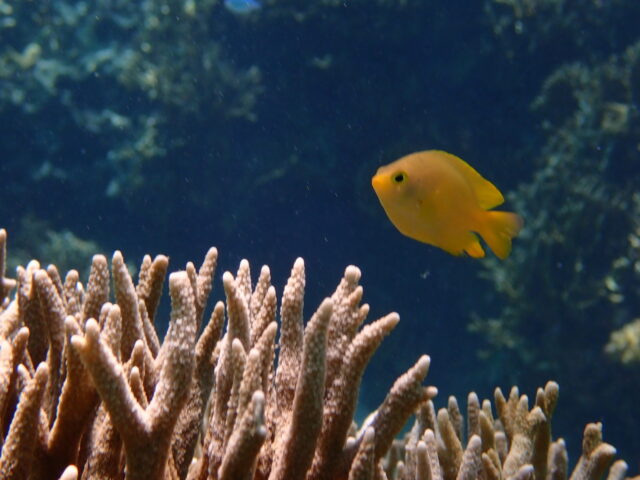
The nettie sparrowhawk is a species of sparrowhawk that is abundant in shallow coral areas. They live amongst branching corals and schools of sparrowhawks.
The body color is bright yellow with a black spot on the basal upper edge of the pectoral fin. Juvenile fish are as brightly colored as live fish.
yellowfin goatfish (Mulloidichthys vanciolensis)

The red goatfish is most commonly found in areas with tidal currents, such as coral reefs and the outer edges of coral reefs at depths of about 20 meters.
During the day, they swim in schools in the middle of the ocean, but disperse at night. Their body color varies from red, yellow, and white, and they have a single yellow longitudinal band down the middle of their body.
latticed butterflyfish (Chaetodon rafflesii, species found in the Indo-Pacific)
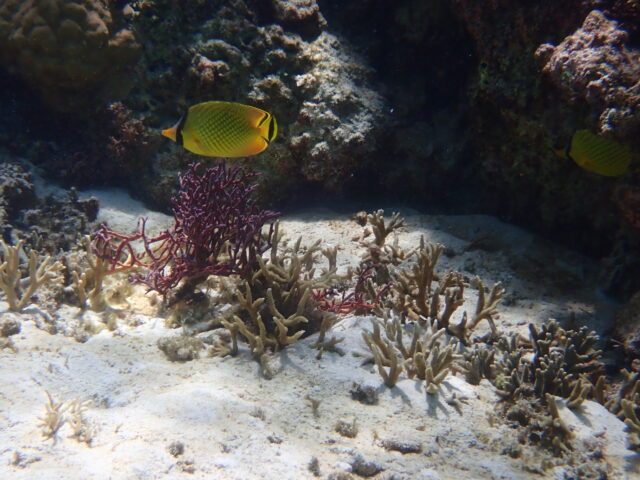
The mysid butterflyfish is a species of butterflyfish that lives in coral reef areas at depths shallower than 15 meters.
It is more difficult to find than other butterflyfishes because its population is smaller. It has a single black band on its head, and its body color is yellow with a reticulated pattern.
The dorsal-fin soft-stripe has a thick black band running along the outer edge, and the length of the body is around 11 cm.
Papuan black snapper (Lutjanus goldiei)

Ukeguchi ittoidai are found in shallow water in coral areas and rocky areas, often lurking in their pores during the day.
The body has large black spots and numerous longitudinal bands. Body length is about 20 cm.
sea turtle

Unlike land turtles, sea turtles differ in that their forelimbs are fin-like to allow them to swim freely in the sea, and their shells are streamlined to reduce water resistance.
◆Loggerhead turtle (Caretta caretta)
◆tai mai
Although they live in the sea, they breathe with their lungs, a remnant of land turtles, and visit beaches when they lay eggs.
Some natural beaches on Miyako Island are,Sea turtles visit to lay eggsIt is a valuable spot.
⬇︎ for more information about sea turtles in Miyako Island.
 The Complete Guide to Sea Turtles on Miyako Island! The definitive guide to choosing a beach, time of year, and tour for the 99% encounter rate!Sea turtles" are popular on Miyako Island. We introduce tours where you can meet sea turtles in Miyako Island! Let's swim with sea turtles by observing the rules and manners!
The Complete Guide to Sea Turtles on Miyako Island! The definitive guide to choosing a beach, time of year, and tour for the 99% encounter rate!Sea turtles" are popular on Miyako Island. We introduce tours where you can meet sea turtles in Miyako Island! Let's swim with sea turtles by observing the rules and manners!Click here for ⬇︎ recommended sea turtle snorkel tours.
 Special Winter SALE [Miyako Island/2 hours] Same-day reservations OK! Amazing encounter rate♪ Sea turtle snorkeling tour Beginners welcome☆ (No.934)開始時間8:30-10:00 / 10:30-12:0013:30-15:00 / 15:30-17:00所要時間Approx. 2 hours7,900 yen →6,900yen
Special Winter SALE [Miyako Island/2 hours] Same-day reservations OK! Amazing encounter rate♪ Sea turtle snorkeling tour Beginners welcome☆ (No.934)開始時間8:30-10:00 / 10:30-12:0013:30-15:00 / 15:30-17:00所要時間Approx. 2 hours7,900 yen →6,900yen Miyakojima Island/2 hours] Sea Turtle Encounter Rate 99%☆Reservations on the day & from 3 years old OK!開始時間8:30-10:30 / 10:30-12:30 / 13:00-15:00 / 15:00-17:00所要時間Approx. 2 hours12,000 yen →7,900yen
Miyakojima Island/2 hours] Sea Turtle Encounter Rate 99%☆Reservations on the day & from 3 years old OK!開始時間8:30-10:30 / 10:30-12:30 / 13:00-15:00 / 15:00-17:00所要時間Approx. 2 hours12,000 yen →7,900yen Miyakojima】Sea turtle snorkeling & 4 kinds of marine sports experience course<Banana board, big marble, band wagon, jet ski>Free photo(No.813)開始時間Negotiable所要時間Approx. 3 hours22,000 yen →20,000yen
Miyakojima】Sea turtle snorkeling & 4 kinds of marine sports experience course<Banana board, big marble, band wagon, jet ski>Free photo(No.813)開始時間Negotiable所要時間Approx. 3 hours22,000 yen →20,000yen
clownfish (Balistoides conspicillum)

The clownfish made famous by the Disney movie "Finding Nemo".
In fact, it is said that the fish that Nemo was modeled after is a closely related species, the orange clownfish.
Such clownfish are marine fish that are famous for their orange-ground body color with black and white bands running across it, and for their symbiotic relationship with sea anemones.
yellow tang (Zebrasoma flavescens, species of Pacific tang)

The yellow-bellied hagfish is a species of hagfish about 15 cm long that inhabits coral reefs and rocky reefs and feeds on attached algae.
As the name implies, the yellow-bellied hogfish is all yellow in body color, with white movable spines on the caudal peduncle.
black sea cucumber (Holothuria atra)

The black sea cucumber, as its name suggests, is a sea cucumber whose entire body is black.
They release mucus from the surface of their bodies and cover themselves with sand. They live by filtering organic matter from the sand on their bodies.
titan triggerfish (Balistoides viridescens)

The sesamoa is a large marine fish, up to 50 cm in length, that lives in shallow waters where corals grow in colonies.
As juveniles, they are found attached to current algae or in tidal pools. It has a dark band extending from the head to the front of the gills, and the outer edges of the dorsal, anal, and caudal fins are black.
convict surgeonfish (Acanthurus triostegus, species of the Indo-Pacific)

Both juveniles and juvenile striped surgeonfish are common species that inhabit the Pacific Ocean from Honshu to the coast of Kyushu, living on coral reefs and rocky reefs where they feed on attached algae.
The body color is generally pale and has about five or six black transverse bands. The scales have no patterns or colors, and when exposed to light they glow silver, making it a very beautiful fish. The length of the body is about 20 cm.
saddleback butterflyfish (Chaetodon ephippium, species of the Indo-Pacific)

The seguro butterflyfish is mainly found in coral reefs and is one of the largest butterfly fish species, reaching up to 30 cm in length.
As juveniles, a black band runs through the eye, but becomes indistinct as adults. The back and underside of the body are edged in white, and the tip of the tail is reddish.
sixbar wrasse (Thalassoma hardwicke)

Senasji wrasses are found in shallow coral areas and reefs. They rest behind rocks and corals at night and become active during the day.
As the name suggests, the upper part of the body, the back, has several black or peach-colored oblique bands. The head has red spots, and the length of the body is about 15 cm.
moorish idol (Zanclus cornutus, species of Indo-Pacific perciform fish)

Although the horned fish looks very similar to the butterfly fish, they are completely different species.
This species is closely related to the Nizadidae family and has similar morphological traits, but lacks the spines on the caudal peduncle.
It has a small projection on the septum of the eye and a distinctive black caudal fin. They can be easily distinguished from other species because they can be found in groups. The length of the body can reach up to 20 cm.
blue-green chromis

The debasseled sparrowfish is a common species with a bright blue-green body color that can frequently be seen in coastal coral reef areas.
It is similar to the blue-bellied sparrowfish, but is easily distinguished by the absence of black spots on the axillae of the pectoral fins.
Adults are only about 7 cm in length, and as juveniles they live near large branching corals, where they hide when they sense danger.
yellowtail amberjack (species of fish, Seriola lalandi)

Hamadryas are marine fish that live symbiotically with anemones near coral reefs, about 12 cm in length.
It is a member of the bear family, but has no white transverse band on the body and a broad white transverse band on the head.
bluestreak cleaner wrasse (Labroides dimidiatus)

The reef inhabitant, the Honsome Wavefish, lives in reef areas and feeds on attached algae.
It is known for cleaning and is not preyed upon by larger fish. They are about 10 cm long and have a single longitudinal band from eye to tail.
pinktail durgon (durgeon) (triggerfish) (Melicthys vidua)

Murasame mongara is a common species, about 20 cm long, that inhabits coral reefs in shallow waters.
They are especially abundant in sandy and rocky reefs, and can be found by snorkeling in those areas.
A blue band extends behind the maxilla, and a triangular yellow band runs further posteriorly to the lower pectoral-fin base. The caudal peduncle has three rows of small spines and three blue lines running from the eyes to the pectoral fins.
whitetail dascyllus (Dascyllus aruanus, species of damselfish from the Indo- West Pacific)
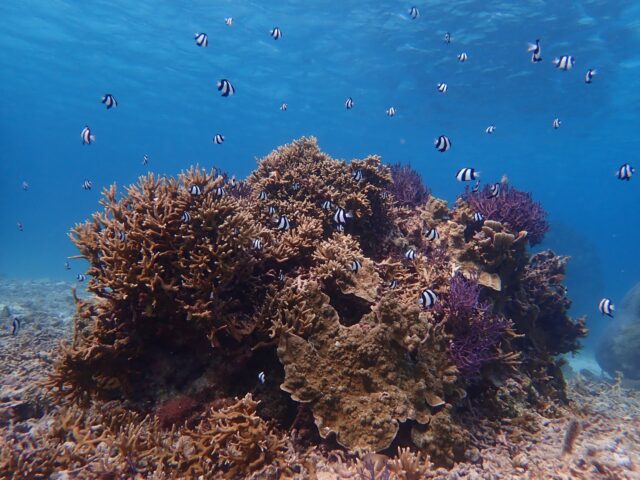
The misshapen sparrowhawk is a species of sparrowhawk that lives in coral reef areas and on sandy bottoms, sometimes living on branching corals and forming schools with other species of sparrowhawks.
It is about 7 cm long, white in color, and has three black transverse bands running from the head to the body.
summary

We have introduced the fish of Miyako Island. How was it?
From brightly colored tropical fish to familiar fish that also live in the mainland ocean. We hope you will try to get in touch with the fishes of Miyako Island through our activities.
⬇︎Click here to read the article in conjunction with ⬇︎
 30 popular snorkeling spots in Okinawa! Thorough explanation by staff living in Okinawa!Contents1 Recommended Snorkeling Spots2 Okinawa Islands Area (Around Okinawa Main Island)2.1 Okinawa Main Island2.2 Kerama Islands2.3 Minnajima3 Yaeyama Islands Area3.1 Ishigaki Island3.2 Iriomote Island3.3 Kohama Island [...].
30 popular snorkeling spots in Okinawa! Thorough explanation by staff living in Okinawa!Contents1 Recommended Snorkeling Spots2 Okinawa Islands Area (Around Okinawa Main Island)2.1 Okinawa Main Island2.2 Kerama Islands2.3 Minnajima3 Yaeyama Islands Area3.1 Ishigaki Island3.2 Iriomote Island3.3 Kohama Island [...]. Introducing recommended skin diving spots in Miyako Island & skin diving tours where you can swim with sea turtles!Contents1 You may be able to swim with sea turtles☆ Let's enjoy skin diving in Miyako Island! 2.1 Clear water! High chance of encountering sea turtles. 2.2 Impressed by the magnificence of nature! A beautiful underwater world like a painting 2.3 One [...]
Introducing recommended skin diving spots in Miyako Island & skin diving tours where you can swim with sea turtles!Contents1 You may be able to swim with sea turtles☆ Let's enjoy skin diving in Miyako Island! 2.1 Clear water! High chance of encountering sea turtles. 2.2 Impressed by the magnificence of nature! A beautiful underwater world like a painting 2.3 One [...]
